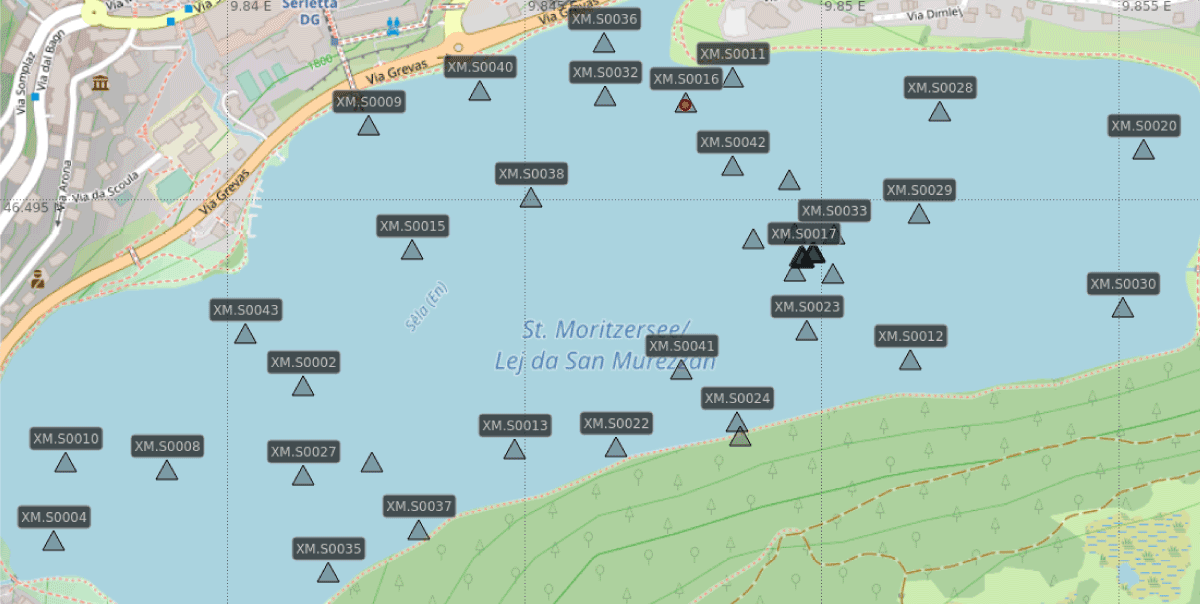2025-04-02
Recording icequakes on Lake St. Moritz
For the third winter in the past five years, the Swiss Seismological Service (SED) and the Institute of Geophysics (IfG) at ETH Zurich have recorded icequakes on the frozen Lake St. Moritz. The two-week campaign in February aimed to provide valuable insights into using seismological techniques to measure ice thickness, to evaluate the effectiveness of various monitoring methods, and to gain experience that could one day be applied to space missions exploring icy moons.
At the beginning of the year, the frozen Lake St. Moritz is a hive of activity: horse and cars races, parachutists, golf tournaments, and concerts entertain tourists and the public. Amidst the daytime bustle, the ice’s natural sounds go unnoticed. But as night falls and the temperatures drop, a different kind of spectacle begins. The ice layer seems to come alive, cracking and making sounds. These sounds are not only audible to the human ear. The dynamic processes within the ice layer were also recorded by 43 seismic nodes and a 3-kilometre-long fiber-optic cable.
Seismicity on ice: from frozen Swiss lakes to icy moons
Just like earthquakes caused by plate tectonics, ice quakes occur when ice expands, contracts and moves, building up stress until it fractures. However, since icequakes occur in a thin layer of ice over the lake water, their signals differ significantly from those of earthquakes. The project on Lake St. Moritz provides key insights into these differences, deepening our understanding of icequake generation, ice tectonics, and icequake seismicity.
Seismic waves scan the structure beneath the surface like X-rays scan the body. Using a dense seismic network installed on the lake in mid-February, researchers aim to map the ice and to track changes in ice thickness over time. Direct measurements showed a uniform thickness of at around 45-50 cm across Lake St. Moritz, increasing by about 5 cm over the two weeks. Since deploying such dense networks is a great deal of effort, the goal is to develop methods for remote monitoring of ice thickness with fewer stations in the future.
Beyond better understanding icequakes, the results may also contribute to future space missions to the icy moons of Saturn or Jupiter, where the conditions are similar to those on frozen lakes. Studying the behavior of seismic waves in ice on Earth provides valuable insights into the signals to be expected on icy moons and how they can be measured.

Seismogram of an icequake.
Seismic instruments can detect very small vibrations well below what humans can perceive. However, the daytime activity on the Lake St. Moritz is so great that icequakes are lost in this so-called “seismic noise”. Therefore, the researchers focus on data recorded between 9 p.m. and 6 a.m. for accurate analysis.
In addition to the SED’s seismic network, the Exploration and Environmental Geophysics and the Seismology and Wave Physics Groups at ETH Zurich installed 3 kilometers of Distributed Acoustic Sensing (DAS) fiber-optic cable on the ice to assess the potential of this cutting-edge DAS technology for monitoring both ice and earthquakes.
DAS provides continuous, high-resolution monitoring of strain vibrations along entire the length of the cable, complementing data from seismic nodes. Changes in the scattering pattern of the light signal, caused by ground displacements, allow highly precise measurements of the deformation along the cable.
By analysing the data recorded by the DAS cable and the seismic nodes, the research team aims to take the next step in refining monitoring methods and deepening our understanding of icequakes.

Map of the deployed seismic node network on Lake St. Moritz.
